Poverty in rural Scotland: evidence review
This report reviews current evidence and research on rural poverty in Scotland
4. Cost of Living
Summary:
- Weekly food, clothing and household goods costs are higher in the islands and remote rural Scotland, compared to urban areas in the UK.
- Individuals in remote rural areas pay substantially higher prices for home delivery than individuals in urban areas.
- Travel is the greatest source of additional costs for residents of remote rural Scotland and can add over £50 a week to costs for rural households.
- Residents in rural Scotland are more likely than those in the rest of Scotland to spend over £100 per month on fuel for their cars.
- A third of households in remote rural areas are classed as 'extreme fuel poor', compared to only 12% in accessible rural areas and 11% in the rest of Scotland.
A Scottish Government (2021e) report estimates that the minimum cost of living in remote rural Scotland is between 15% and 30% higher than urban parts of the UK. The research suggests that this is on account of significant additional costs, such as food, clothing, household goods and holidays. The cost of travel, however, was identified as the dominant extra cost. It is likely, therefore, that households in remote rural Scotland require a higher income to attain the same minimum living standard as those living elsewhere in the UK.
4.1 Food, clothing and household goods
The report (Scottish Government, 2021e) found that weekly food costs are up to 13% more for island communities and up to 4% higher in remote rural Scotland, compared to urban areas in the UK. While the cost of food is not significantly higher in rural and island supermarkets, at local community stores, costs were 44% higher on the mainland and 27% higher on islands than the equivalent in a supermarket.
| Urban UK | Remote rural mainland | % difference to urban UK | Island | % difference to urban UK | |
|---|---|---|---|---|---|
| Couple + 2 | £112.43 | £117.08 | 4% | £126.70 | 13% |
| Working age single | £49.69 | £50.60 | 2% | £52.06 | 5% |
| Working age couple | £83.13 | £84.64 | 2% | £87.06 | 5% |
| Pensioner single | £47.10 | £48.30 | 3% | £51.97 | 10% |
| Pensioner couple | £75.25 | £77.04 | 2% | £79.57 | 6% |
Source: The cost of remoteness. Additional minimum living costs in remote rural Scotland, Scottish Government (2021e) (using the Scottish Government Urban Rural Classification)
Weekly clothing (see Table 9) costs were also estimated to be higher in rural and islands areas, ranging from between 18% (remote rural) and 34% (islands) higher for pensioner couples and between 10% (remote rural) and 12% (islands) higher for families with children. For household goods (see Table 10), costs are again significantly higher in islands (between 10% and 22%) than in remote rural areas on the mainland (between 4% and 10%). The single biggest source of these differences are the higher costs of larger items bought locally.
| Urban UK | Remote rural mainland | % difference to urban UK | Island | % difference to urban UK | |
|---|---|---|---|---|---|
| Couple + 2 | £44.66 | £49.26 | 10% | £50.20 | 12% |
| Working age single | £7.99 | £9.07 | 14% | £10.63 | 33% |
| Working age couple | £15.98 | £18.14 | 14% | £21.25 | 33% |
| Pensioner single | £6.99 | £8.24 | 18% | £9.34 | 34% |
| Pensioner couple | £13.98 | £16.47 | 18% | £18.67 | 34% |
Source: The cost of remoteness. Additional minimum living costs in remote rural Scotland, Scottish Government (2021e) (using the Scottish Government Urban Rural Classification)
This is often exacerbated by significantly higher delivery costs to rural and remote areas. Research published by Citizens Advice Scotland (2015) suggests that rural consumers often find that they are excluded from home delivery options or face high delivery surcharges. A Scottish Government (2020d) report found that individuals in remote rural areas pay substantially higher prices than individuals in urban areas. The most prominent differences in prices and delivery probability are for next-day door-to-door deliveries where the price for islands is almost double than in the rest of the country and 75% more expensive in remote rural Scotland.
According to the findings, the Highlands and Islands face the highest delivery prices on average among all regions and the lowest delivery probability. Similarly, surcharges are concentrated in the councils of Moray, Argyll and Bute, Highland, Na h-Eileanan Siar, Orkney Islands and Shetland Islands. More recently, Scottish Government (2021e) research found that delivery costs were most significant for island pensioners, for whom they added around £3 a week on average to household budgets.
| Urban UK | Remote rural mainland | % difference to urban UK | Island | % difference to urban UK | |
|---|---|---|---|---|---|
| Couple + 2 | £27.56 | £28.64 | 4% | £30.34 | 10% |
| Working age single | £10.05 | £11.07 | 10% | £12.25 | 22% |
| Working age couple | £12.22 | £13.46 | 10% | £14.89 | 22% |
| Pensioner single | £15.39 | £16.39 | 7% | £18.04 | 17% |
| Pensioner couple | £17.55 | £18.69 | 7% | £20.58 | 17% |
Source: The cost of remoteness. Additional minimum living costs in remote rural Scotland, Scottish Government (2021e) (using the Scottish Government Urban Rural Classification)
4.2 Transport
As can be seen in Table 11, adults in remote rural (75%) and accessible rural areas (82%) are more likely to drive to their place of work or education than adults in the rest of Scotland (60%).
| Remote Rural | Accessible Rural | Rest of Scotland | |
|---|---|---|---|
| Walking | 14% | 6% | 13% |
| Driver of a car or van | 75% | 82% | 60% |
| Passenger in a car or van | 3% | 4% | 5% |
| Bicycle | 1% | 1% | 3% |
| Bus (ordinary or works) | 3% | 2% | 11% |
| Rail | 1% | 4% | 6% |
| Other | 2% | 2% | 2% |
Source: Scottish Household Survey 2019, Scottish Government (2021b) (using the Scottish Government Urban Rural Classification)
Evidence suggests that transport costs are much higher in rural areas, particularly for working-age households. A Scottish Government (2021e) report found that travel is by far the greatest source of additional costs for residents of remote rural Scotland. Greater travel distances (especially for work, but also for shopping leisure/holidays and accessing services), the greater need to own at least one car and higher fuel costs, can add over £50 a week to costs for rural households. As can be seen in Table 12, weekly travel costs are estimated to be up to 251% higher for pensioners living in remote rural areas on the mainland.
| Urban UK | Remote rural mainland | % difference to urban UK | Island | % difference to urban UK | |
|---|---|---|---|---|---|
| Couple + 2 | £102.10 | £157.01 | 54% | £130.52 | 28% |
| Working age single | £43.30 | £74.73 | 73% | £60.78 | 40% |
| Working age couple | £86.65 | £144.78 | 67% | £117.34 | 35% |
| Pensioner single | £15.42 | £54.10 | 251% | £43.89 | 185% |
| Pensioner couple | £19.16 | £53.84 | 181% | £44.44 | 132% |
Source: The cost of remoteness. Additional minimum living costs in remote rural Scotland, Scottish Government (2021e) (using the Scottish Government Urban Rural Classification)
As can be seen in Figure 6, residents in rural Scotland are more likely than those in the rest of Scotland to spend over £100 per month on fuel for their cars. The proportion of those spending more than £100 per month on fuel for their cars is highest in accessible rural areas at 55%. The proportion is 47% in remote rural areas. In the rest of Scotland this falls to 39%. A higher level of expenditure on fuel for cars is likely to be, in part, due to longer driving distances to key services, as well as the distance travelled to work.
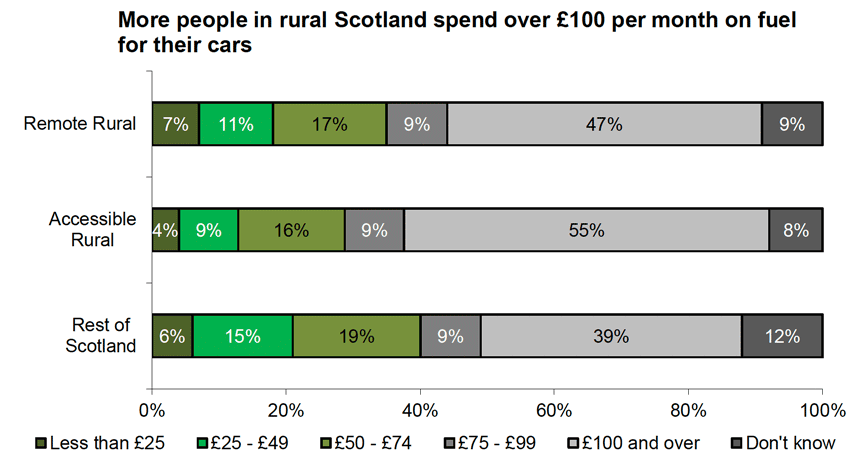
Source: Scottish Household Survey 2019, Scottish Government (2021b) (using the Scottish Government Urban Rural Classification)
Research suggests that people living in rural areas also pay higher bus fares than people living in urban areas (Citizens Advice Scotland, 2016). As can be seen in Figure 7, the median return bus fare paid to access essential services is largely higher in accessible rural and remote rural areas. The median return bus fares to colleges, jobcentres and hospitals are especially higher in remote rural areas.
This poses a number of challenges for rural residents who rely on public transport. Travel to Jobcentres, for example, is necessary for many people receiving certain social security payments. Regular meetings with work coaches are an essential requirement in the Universal Credit system, for instance. Repeated trips could, thus, be costly for remote rural residents. Similarly, access to hospital-based health and social care may be restricted for those relying on public transport. Indeed, the report notes that the infrequency of rural bus services may require rural residents to use more expensive forms of public transport, such as taxis, or restrict their availability for in-person medical appointments to times when public transport is running.
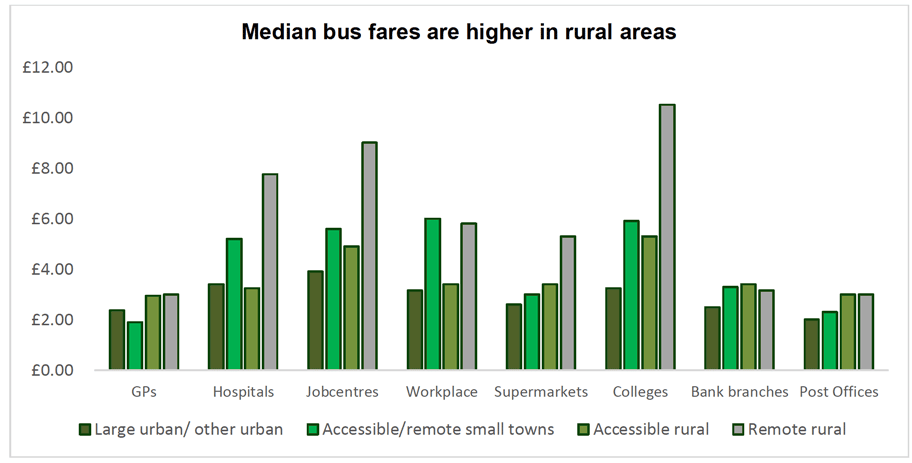
Source: Citizens Advice Scotland (2016)
The cost of transport is also a particular issue in the islands. Research by the Scottish Government (2021c) found that less than half of island residents agree that local bus and ferry fares are good value. Additionally, less than one in five residents feel that the flights to and from the mainland are good value for money.
4.3 Housing
Data suggests that housing in rural Scotland is more expensive than the housing in urban areas. Indeed, the average (mean) residential property price was £198,908 in remote rural areas (up by 6% since 2019) and £228,556 in accessible rural areas (up by 9% since 2019), compared to £171,362 in the rest of Scotland (up by 4% since 2019) (Scottish Government, 2021b). This does not necessarily indicate that housing is unaffordable. Rather, household incomes may be substantial enough to cover higher housing costs. However, in the islands, for example, only a third of residents agree that there is affordable housing locally (Scottish Government, 2021c).
Similarly, according to a recent report - 'Rural Lives- Understanding financial hardship and vulnerability in rural areas' (Shucksmith et al. 2021) - a lack of affordable housing in rural areas has meant that it remains difficult for financially vulnerable groups to access suitable housing in rural areas. The report argues that rural residential housing stock is often not appropriate for the needs of young people and single person households, and there are issues with the quality of private rented accommodation.
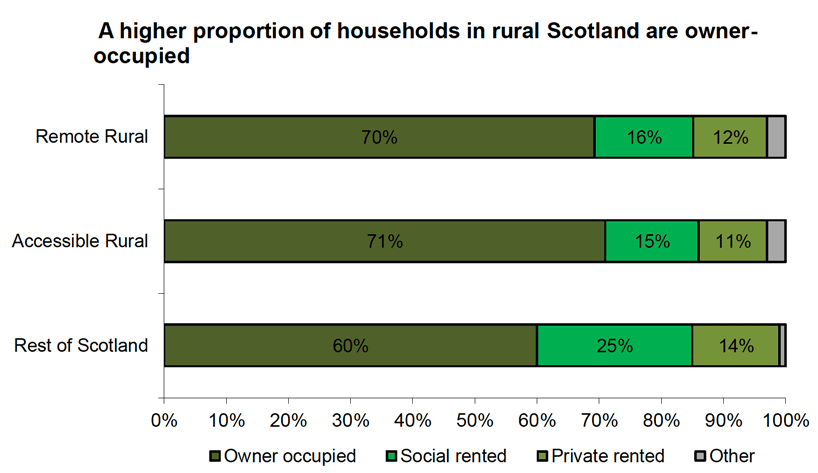
Source: Scottish Household Survey 2019, Scottish Government (2021b) (using the Scottish Government Urban Rural Classification)
As can be seen in Figure 8, a higher proportion of households in rural Scotland are owner-occupied (70% of households in remote rural areas and 71% of households in accessible rural compared to 60% in the rest of Scotland). A smaller proportion of rural households rent from local authorities or housing associations (16% in remote rural areas and 15% in accessible rural areas, compared with 25% in the rest of Scotland). The rate of private renting is higher in the rest of Scotland at 14% compared to 11% in accessible rural areas and 12% in remote rural areas.
According to the Skerrat et al. (2014, 73), 'drivers for this can include a lack of social housing; a lack of availability of homes to rent, a high number of second homes/holiday lets…; planning challenges and a lack of available land.' They also argue that rental properties in rural areas are unaffordable and that available properties may only offer seasonal and short term leases. They link this to tourism industries, second homes and the seasonal nature of agricultural employment.
Indeed, remote rural areas had the highest proportions of second homes, with 6.3% of dwellings being used as second homes (National Records of Scotland, 2020). This goes some way to explain why 71% of island residents agree that there is a high proportion of local holiday lets and second homes (Scottish Government, 2021c).
The condition of rural housing stock also contributes to the cost of living in rural Scotland, as is discussed in 4.4.
4.4 Household fuel bills
The Scottish Government (2020e) states that households should be able to afford the heating and electricity needed for a decent quality of life. A household is in fuel poverty if in order to maintain a satisfactory heating regime, total fuel costs necessary for the home are more than 10% of the household's adjusted (i.e. after housing costs) net income; and if, after deducting those fuel costs, benefits received for a care need or disability and childcare costs, the household's remaining adjusted net income is insufficient to maintain an acceptable standard of living.
Extreme fuel poverty follows the same definition except that a household would have to spend more than 20% of its remaining income to pay for its energy needs.
Figure 9 shows that around a third of households in remote rural areas are classed as 'extreme fuel poor'. This compares to only 12% in accessible rural areas and 11% in of Scotland. Between 2018 and 2019, rates of fuel poverty increased in remote rural areas (from 33% to 43%), increasing the gap when comparing overall urban (24%) to overall rural areas (29%). Similarly, levels of extreme fuel poverty increased in remote rural areas (from 23% to 33%), meaning that extreme fuel poverty rates in rural areas (19%) were higher than in urban areas (11%).
Research in Scotland's (2021c) islands showed that 73% of islanders agreed that their heating bills have increased in the past year, with 13% stating that they could not afford to keep their home warm in the past year. Over a third of island residents also stated that their home sometimes feels uncomfortably cold in the winter, with 8% having had to choose between keeping their home warm and buying food or essential for themselves and their family.
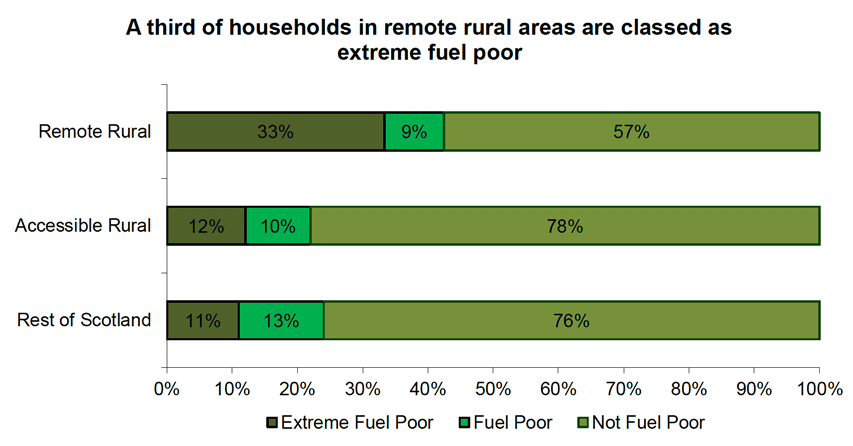
Source: Scottish House Condition Survey 2019, Scottish Government (2021c) (using the Scottish Government Urban Rural Classification)
According to the 2019 Scottish House Condition Survey (Scottish Government, 2020c), rural households are at risk of fuel poverty for a number of reasons:
- 65% of rural dwellings are not within the coverage of the gas grid. They are, thus, dependent on alternative fuel types, such as electric storage heating and oil-powered heating, that are substantially more expensive. Consequently, the rates of extreme fuel poverty for households outwith the coverage of the gas network (19%) are higher than for households within coverage of the gas network (11%).
- There are higher rates of electricity and oil as primary heating fuel in rural locations, 20% and 28%, respectively, compared to urban locations where electricity is used in 9% and oil in less than 1% of dwellings.
- Properties heated by mains gas have, on average, higher energy efficiency ratings, with dwellings heated by other fuels (including electric and oil) having, on average, considerably lower ratings.
- As dwelling characteristics associated with lower energy efficiency are disproportionately represented in rural areas, the average energy efficiency profile of rural properties is lower than that for urban.
- Rural dwellings are, on average, 31% larger than urban dwellings. They, thus, require greater heat inputs and cost more to heat.
Although fuel poverty is linked to low income, it is not to be confused with income poverty. The Scottish House Condition Survey (Scottish Government, 2020c) shows almost three-quarters of fuel poor households would be considered poor in terms of their income (73% or 448,000) while the other quarter have incomes above the relative poverty threshold (27% or 165,000 households) in 2019. Those who are not income poor but experience fuel poverty have a higher likelihood of living in low energy efficiency properties, using electricity for heating, and living in rural areas compared to fuel poor and income poor households and Scotland overall. As can be seen in Figure 10, 29% of fuel not income poor households are in rural areas.
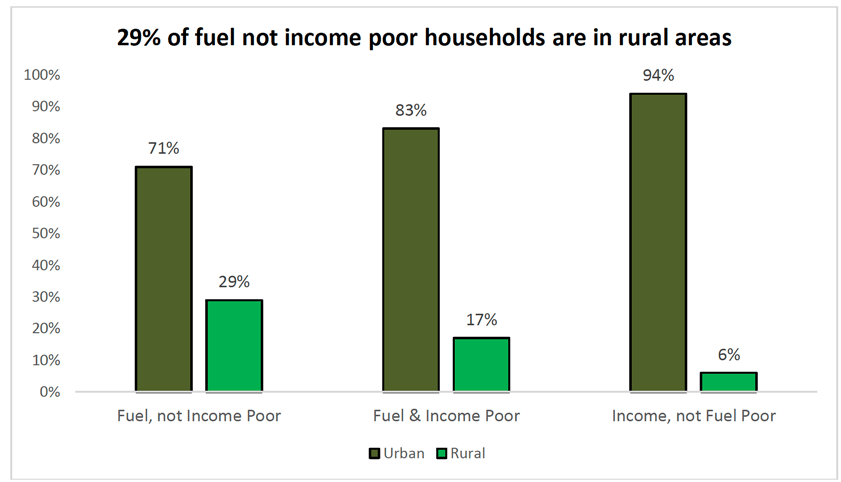
Source: Scottish House Condition Survey 2019, Scottish Government (2020c) (using the Scottish Government Urban Rural Classification)
Contact
Email: socialresearch@gov.scot
There is a problem
Thanks for your feedback